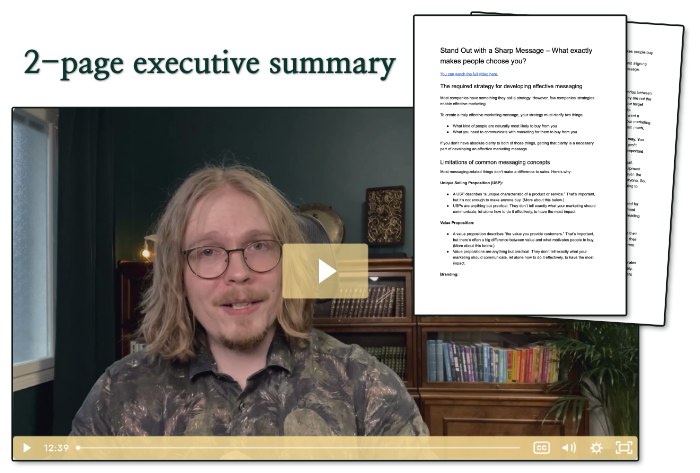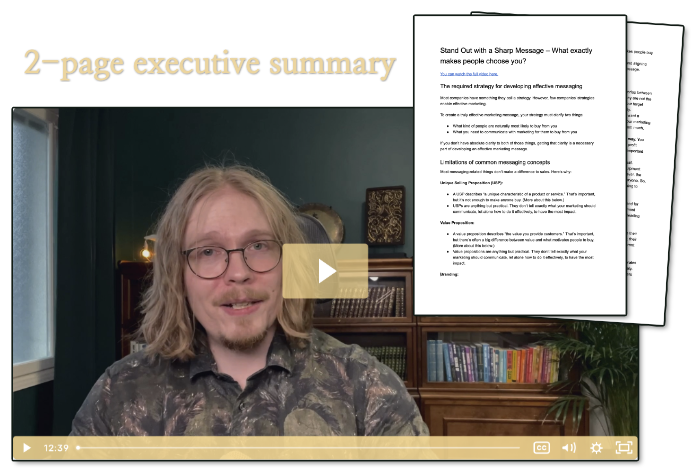What are buyer personas?
Buyer personas are the individual and identifiable groups of people who buy your products. For example, a stereo store has at least three important and very distinct buyer personas (this is based on my experience of working in one years ago).
Stereo store example:
1. Those looking for a better stereo system. They’re usually men and they generally don’t mind the appearances of the stereo system. Instead they want the ability to listen to LP’s, radio, and CD’s, and just relax with music. They’re not satisfied with their current stereos, so they’ve decided to pay a little more than what they paid for the previous set. But they do have an understanding about the price range they’re looking into. They’re not the most patient customers, but they probably don’t need the products immediately. They like the feeling they get when they buy a new gadget.
2. Hi-fi enthusiasts. A group of almost solely men, who will spend a lot of time pondering the purchase. They’ll test every possible product at their home. They’re interested in technical specifics. They enjoy the process of testing more than the purchase. They like to talk about their preferences and hear the sales people’s ideas, but they don’t believe anyone but themselves. Price is very important; the higher the better, they’ll often buy the most expensive option they can afford … and then some.
3. Women (apologies for the generalization, this is just one buyer persona) looking for something that will satisfy their men’s desire for new gizmos, and their own sense of esthetics. They’re very price concerned. Only technical specifics are less important than the actual sound quality.
These buyer personas aren’t extremely specific, but they give you the idea of what a buyer persona means. Different buyer personas are looking for different things, so you should treat them differently. And not only in the sales situation, but in your marketing too.
How to profile buyer personas
Firstly, all the people who visit your store or your website aren’t buyers. Base your assessment of your buyer personas on buying customers, not browsers, yourself, thieves, or friends visiting you. But what should a buyer persona define? And remember: you’re like to have more than one buyer persona for your business; specify as many as you can think of.
1. Gender. I realize this may feel awkward for some people, but you should know the gender of a specific buyer persona. But only if it’s relevant. Some buyer personas are not gender specific.
2. Age. The age of a buyer persona is the simplest part of the profile. The age of a person can tell you a lot abut them. How you view the world and what you prioritize are often affected by your age. It often also affects why you’re buying something (as in, what you’re going to use it for).
3. Profession. In B-to-B business you know the profession of the buyer. But in B-to-C business this may not be so obvious. But if you can find a common profession or a status of a buyer, you can make your buyer persona profile much more accurate. It’s also very important to know how well they understand your product, are they professional users of laymen.
4. Financial situation. This is one of the most important aspects of the profile, so make sure you get it right. Don’t concentrate on your customers’ bank accounts, but make note how much they’re willing to pay. And how easily they make the decision to buy; it tells you how important your products are for them.
5. Purpose. Why do they buy your products? Some products have more applications (like fabrics) than others (nail clippers). The purpose of your product is the core of your marketing. If you don’t know what your customers use your product for, you can’t market or sell it effectively.
6. Education. How well-educated is the buyer persona? The educational background makes the profile deeper. It can help you figure out how they process information. Do they understand graphs, statistics, and study results, or are they more concerned with customer testimonials and simplified features.
7. Free time. How do they spend their time? Common hobbies, interests, TV shows, even eating habits can get you closer to them. You cannot know your buyer persona too well, so even these small details can prove to be valuable.
8. Buying decision. Which factors they take into account when they make the decision to buy? Price, features, ease of use, customer service, and resell value, can all play a part in the decision. If you don’t understand this part of your customers, your marketing can only work if you get lucky.
9. Shopping habits. What else do they buy? This is important when you start creating your business network. What else can you offer to them, and what else are they looking for.
What to do with a buyer persona?
When you have detailed buyer personas, you can, and you must, use them in your marketing. Here’s a few ways to use buyer personas in marketing.
1. Address specific people. When you know your buyer, you can talk to him/her directly. You don’t have to say, “you” when you can say, “25-year old man, living in the suburbs”.
2. Address specific problems. Talking about a specific problem is more engaging than a general problem. But it only works if you address a problem your buyers have, so you need to know your buyer personas first.
3. Address specific beliefs. You can create a feeling of being talked directly at with beliefs. For example, “This product is healthy.” is less engaging than, “Your children need more vitamins, that the school system doesn’t provide.”
4. Pinpoint accurate placement. Placement is a key to effective marketing. When you understand your buyer personas, you know where they are, and how to reach them at the right time.
5. Showcasing the right price range. If you market a product a buyer cannot afford, they won’t buy it. And they’ll be left with a belief that you’re over priced for them.
There’s one more thing…
Understanding your buyer personas isn’t enough to create effective marketing. It’s just a part of understanding what is your value proposition.


